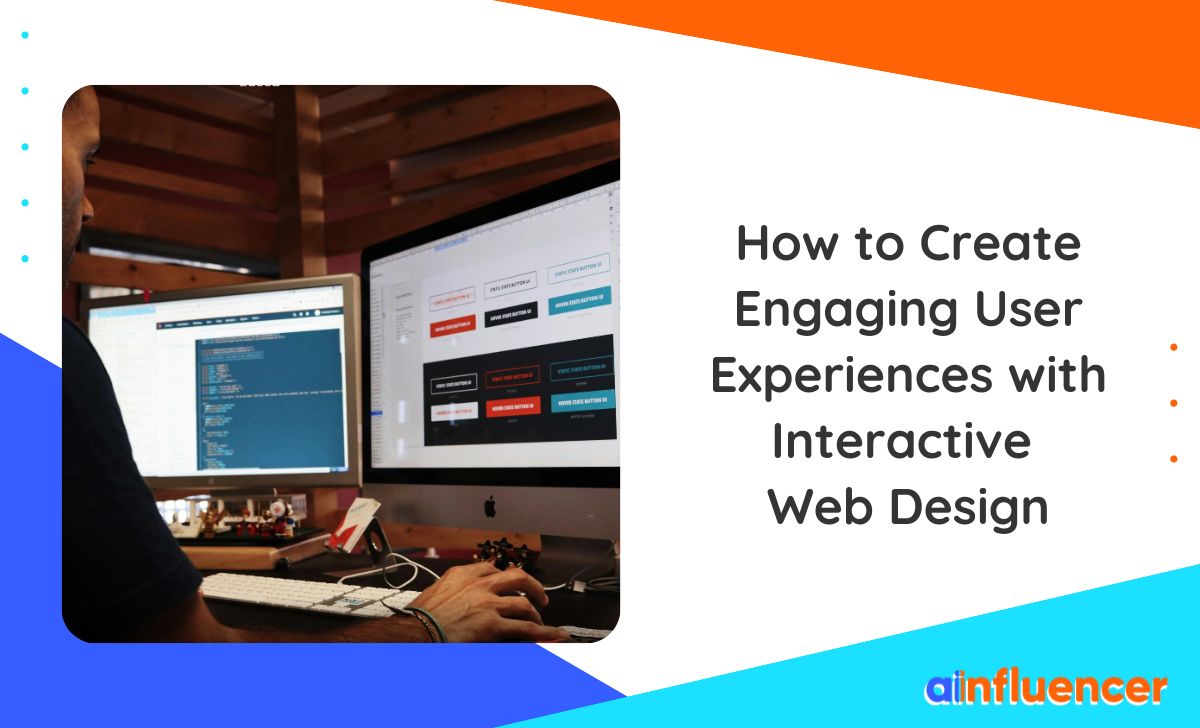A good web design isn’t just about creating a visually appealing website. You need to incorporate user experience (UX), which breathes life into your website by transforming the static elements into an engaging platform. Creating an engaging digital experience requires precision in evoking emotions and connecting a website visitor to the entity behind the web design. Website visitors expect websites and applications to be intuitive and responsive to their needs. Let’s explore the importance of interactive web design and its elements.
What Is an Interactive Web Design?
When you visit a web page, would you rather browse a static site or interact with a visually appealing site? Your web visitors also want the same thing. If you want to form a strong connection with your audience, you need an interactive web design. An attractive web design will retain visitors to your website for a long time.
Interaction design focuses on making human-to-computer interfaces feel like human-to-human interactions. Adding the human aspect to your digital spaces leads to a positive user experience. That’s why interaction design is the soul of UX design. You can achieve a sense of human connection by adding the right elements to the web interface.
An interactive web design includes elements like animations, videos and chatbots that allow users to interact with the website easily. Aside from creating a visual appeal, your web design should provide quick navigation options, search functionalities and engaging graphics. Designing a website with an interactive approach allows the designer to improve user experience and make the website fun.
Whether you are developing a website for e-commerce stores, social networking, or online casinos like Jackpot City, interactive web design features can be incorporated to improve user experience. The use of interactive elements like gamification in Jackpot City encourages players to keep playing casino games to climb the virtual ladder in the leaderboards.
The design also uses visual promotions to highlight special events and casino games like Break Away Deluxe or Lara Croft Temple and Tombs. It also displays welcome bonuses in visually appealing banners, grabbing the attention of first-time players and increasing user experience. To address security, one of the most important aspects of UX, the site is fully licensed and adheres to safety and security procedures.
Why Do You Need an Interactive Website Design?
User interface design and engagement have become important in web design since they create a platform for the audience to interact with content. Interactive elements give websites a competitive edge in the digital space by supporting marketing efforts and capitalizing on the power of interactions. Here are some of the ways interactive web design can boost user experience:
- Enhancing engagement and reducing bounce rate: Creating an interactive website provides a memorable experience to users. The interactions keep users on your website for longer periods and encourage them to keep browsing. For instance, having a search feature on your site allows visitors to find what they are looking for easily.
- Bolstering the site’s authority: Providing an engaging user experience increases traffic to the website. As more visitors engage with your site, you generate a good traffic volume that boosts your ranking on search engines. Hence, you will be an established authority in your niche.
- Up-to-date features: Interactive web design allows the addition of features that make the website update in real time. Although static websites are easy to update, you may need a developer to make regular updates. An interactive website allows real-time updates with minimal IT knowledge.
- Providing a personalized experience: Users love a custom experience when interacting with a website. You can create a web design that meets the visitors’ expectations with interactive elements. Collect data to help you improve user experiences and incorporate prompts that users expect when interacting with the site.
- Higher social presence and competitive advantage: If your website design provides an engaging user experience, you are likely to form connections with casual visitors who often hop from one site to another. Interactive features give you a competitive advantage by providing more value to visitors. The design also makes social media sharing easy. Your audience can easily share polls, quizzes and informative videos on social media.
Pillars of Interactive Web Design
In interactive web design, you need to apply the following principles:
1. Develop a goal-driven design
Visitors have a goal when they visit a website. Hence, the user interface should make it easy for the user to achieve their goal. While the concept sounds simple, it’s easy to focus on furthering your business goals and adding flare to the site. Interactive designs are built on deep knowledge of user goals and preferences. That’s why you need to conduct research and come up with:
- User personas: You should understand how users prefer to interact with your website. You can create a persona based on the behavioural analytics of your targeted audience. The persona will help you create a design based on the user preferences.
- User scenarios: It is important to understand the actions of visitors on a site. You should explore the scenarios and contexts of user interactions with the website. For instance, do seasonal sales notifications make a difference in conversion rates?
- Experience maps: You need to explore the external factors and emotions that could affect user interaction. With a persona map, you can map out the emotional journey of a user.
2. Effortless usability
User interactions need to be intuitive. Hence, your web design should be easy and effortless to use. A user should spend minimal effort figuring out how to interact with your system and spend more time actualizing their goal. For instance, if they are booking a reservation, an interactive design consolidates a multi-step process to guide the website visitor and help them achieve their goal. Designers improve usability by:
- Removing unnecessary steps in a multi-step process
- Using user flows to prioritize important sections
- Creating a visual hierarchy to get the attention of the audience
- Using colour codes to organize controls and features
3. Affordances and signifiers
In an interactive web design, each user action must speak for itself. Affordances are the concept that a function should suggest its meaning, while signifiers give a hint of affordance. For instance, if a user is filling out a form, at the bottom of the page, they should see a submit button to save the changes. A signifier usually represents the round edges and colour difference in the submit button to differentiate it from regular text.
4. Learnability
While you may expect users to remember the use of a function after its first use, the reality is different. It is important to design interactive elements that are predictable, and users can learn their functions. An interactive design eliminates complexity when using the site by creating consistency and predictability.
5. Response and feedback
Every interaction on a website is a conversation between the user and the product. That means your website needs to be friendly, helpful and interesting. Your feedback should be immediate and relevant to project your brand as reliable. Hence, the response time of the website should be fast for every interaction.
Examples of Interactive Elements
Some of the interactive elements that enhance user experience and improve comprehension of the content on the website include:
- Incorporating animations and graphics: Animations are often used to improve the visual appeal, enrich the design and evoke emotions. Using animations in web design grabs users’ attention and provides an immersive experience. You can use animations to make loading fun by visualizing the loading process. Animations also guide users on various processes on the site.
- Use videos and illustrations: If you want to explain a complex process, videos and illustrations are handy. You can blend video elements into the site and content on a static page into a narrative that keeps visitors engaged. You can also use video as background ambiance to enhance story telling in your website.
- Dynamic sliders: Showcase content in an interactive manner with dynamic sliders and carousels. You can create an engaging user interface using visually appealing content that highlights the products and services in a shopping website.
- Clickable map: As the name suggests, a clickable map is interactive and allows people to interact with different locations when they click on the map. You can link the map to services and additional information about the brand. For instance, the map can show branches and the availability of services in various locations.
- Dynamic search and filter option: Ensure users can find what they need faster by providing a dynamic search button. This will enhance website usability and help them find the information they need using filters.
How to Create an Interactive Web Design For Influencers
Whether you are an Instagram or TikTok influencer, you need a reliable website for increased online presence. As a social media influencer, you mostly interact with your audience on Facebook, TikTok, YouTube and Instagram. It may not be apparent why you need a website, but it is crucial for boosting your visibility and leveraging digital marketing strategies.
Social platforms are subject to terms and conditions, and if anything goes wrong or your account is banned, you lose your followers. However, when you have a website, you can repurpose your content for social media and build your following.
You can also use your website to showcase your brand, announce collaborations, and host affiliate links that boost your revenue. Like other interactive web designs, your website will be successful if you:
- Define your objectives: Determine the goal of the website, whether you want to use it to provide information on collaboration or showcase sponsored products.
- Know your audience: Build a user persona of the audience that will interact with your site. Explore their preferences, expectations, and behaviours and tailor the interactive elements to their needs.
- Choose the right interactive elements: Select the appropriate tools for implementing your interactive features. The right tool should implement animations, videos and sliders.
- Design user-friendly interfaces: You need to guide users through your site seamlessly. A user-friendly interface encourages interactions as a user navigates the website.
Conclusion
Interactive website design is the process of creating a website that reacts to users’ actions, providing an engaging experience. If you want to improve engagement in your digital space, an interactive web design is crucial. Your website should be like an easy conversation to encourage users to respond quickly and achieve their goals.

![Read more about the article What Is Ghost Commerce? [A Comprehensive Review in 2024]](https://blog.ainfluencer.com/wp-content/uploads/2024/03/ghost-commerce-featured-300x182.jpg)

![Read more about the article How to Use ChatGPT to Make Money? [The Full Guide in 2024]](https://blog.ainfluencer.com/wp-content/uploads/2024/04/jpeg-optimizer_How-to-Use-ChatGPT-to-Make-Money-300x182.jpg)
![Read more about the article Best Shopify Alternatives in 2024: [Free & Paid]](https://blog.ainfluencer.com/wp-content/uploads/2024/01/featured-300x182.jpg)
![Read more about the article Marketing to Gen Z: [Proven Strategies & Practices in 2024]](https://blog.ainfluencer.com/wp-content/uploads/2024/04/jpeg-optimizer_facebook-1-300x182.jpg)



